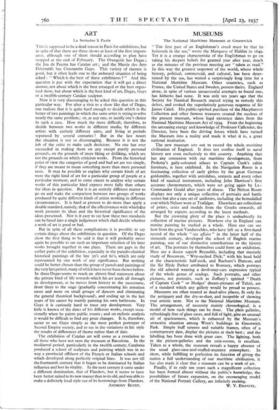ART
La Sernaine h Paris
THIS is supposed to be a dead season in Paris for exhibitions, but in spite of that there are three shows at least of the first import- ance, although one of them should according to plan have stopped at the end of February. The Orangerie has Degas ; the Jeu de Paume has Catalan art ; and the Musee des Arts Decoratifs has Constantin Guys. This variety of themes is good, but it often leads one to the awkward situation of being asked : " Which is the best of these exhibitions ? " And this question is put with the expectation that it will get a direct answer, not about which is the best arranged or the best organ- ised show, but about which is the best kind of art, Degas, Guys or a twelfth-century Catalan sculptor.
Now it is very discouraging to be asked this question in this particular way. For after a visit to a show like that of Degas, one realises that it is quite hard enough to decide which is the better of two paintings in which the same artist is trying to solve nearly the same problem; or, at any rate, to justify one's choice in such a case. How much the more difficult, therefore, to decide between two works in different media, by different artists with entirely different aims, and living at periods separated by several centuries ! But in the last resort the situation is not so discouraging. Because it is not the job of the critic to make such decisions. No one has ever succeeded in making them on any except purely personal grounds, on the grounds of mere liking or disliking, which are not the grounds on which criticism works. From the historical point of view the categories of good and bad art are too simple, if they are meant to mean something more than mere personal taste. It may be possible to explain why certain kinds of art were the right kind of art for a particular group of people at a particular moment, and to some extent to analyse why certain works of this 'particular kind express more fully than others the ideas in question. But it is an entirely different matter to go on and make the comparison between two groups of works produced by quite different kinds of artists working in different circumstances. It is hard at present to do more than apply a double standard, namely, that of the effectiveness with which the work presents its ideas and the historical significance of the ideas presented. Nor is it easy to see how these two standards can be fused into a single judgement which shall decide whether a work of art is good or bad.
But in spite of all these complications it is possible to say certain things about the exhibitions in question. Of the Degas show the first thing to be said is that it will probably never again be possible to see such an important selection of his later works brought together in one place. There are gaps in the earlier parts of the exhibition, especially in the pseudo-classical historical paintings of the late 50's and 6o's, which are only represented by one work of any significance. But nothing could be better chosen than the group of pastels and paintings of the very last period, many of which have never been shown before. In these Degas seems to reach an almost final statement about the private kind of life towards which his art tends all through its development, as he moves from history to the racecourse, from there to the stage (gradually concentrating his attention more and more on small groups of dancers and eliminating the general theatrical background), and ending up in the last years of his career by mainly painting his own bathroom. In Guys it is curiously hard to trace any development. Very little is known of the dates of his different works, except occa- sionally when he paints public events; and on stylistic analysis it would be difficult to find any great changes. It is, therefore, easier to see Guys simply as the most perfect portrayer of Second Empire society, and to see in the variations in his style the results of differences of theme rather than of date.
The exhibition of Catalan art will come as a revelation to all those who have not seen the museum at Barcelona. In the mediaeval period, particularly in the twelfth century, Catalonia produced a school of sculpture and painting which was in no way a provincial offshoot of the French or Italian schools and which developed along perfectly original lines. It was not till the fourteenth century that it began to be dominated by Italian influence and lost its vitality. In the next century it came under a different domination, that of Flanders, but it seems to have been better suited to its new master than to its old, and was able to make a definitely local style out of its borrowings from Flanders.
ANTHONY BLUNT.-










































 Previous page
Previous page